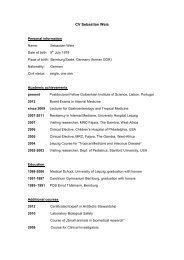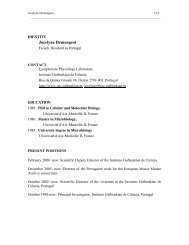organisation - the Instituto Gulbenkian de Ciência
organisation - the Instituto Gulbenkian de Ciência
organisation - the Instituto Gulbenkian de Ciência
- No tags were found...
Create successful ePaper yourself
Turn your PDF publications into a flip-book with our unique Google optimized e-Paper software.
NEUROMETRIC - PSYCHOMETRIC COMPARISON OF INTERVAL TIMING<br />
PERFORMANCE<br />
Tasks in which subjects must categorise sensory stimuli whose characteristics<br />
are parametrically varied have been powerful tools for relating neural processing<br />
to sensation in a rigorous and quantitative manner. We are applying <strong>the</strong><br />
same approach to an unconventional sensory modality, <strong>the</strong> ability to sense <strong>the</strong><br />
passage of time, by training rats on a two alternative forced choice interval<br />
timing task. We can <strong>de</strong>rive quantitative <strong>de</strong>scription of animals’ interval timing<br />
abilities via <strong>the</strong> fitting of psychometric functions to <strong>the</strong>ir choice data and <strong>the</strong>n<br />
compare this to <strong>the</strong> ability of neural activity to enco<strong>de</strong> <strong>the</strong> passage of time.<br />
A tight correspon<strong>de</strong>nce between <strong>the</strong> animals’ behavioural performance and <strong>the</strong><br />
neuronal encoding of time would suggest involvement of those neural signals<br />
in <strong>the</strong> process of timing.<br />
Thiago Gouvea has <strong>de</strong>signed <strong>the</strong> behavioural apparatus, programmed <strong>the</strong> behavioural<br />
control required for <strong>the</strong> task, and has trained four animals. We will<br />
soon be initiating neural recordings during task performance.<br />
IGC ANNUAL REPORT ‘11<br />
RESEARCH FELLOWS<br />
80






